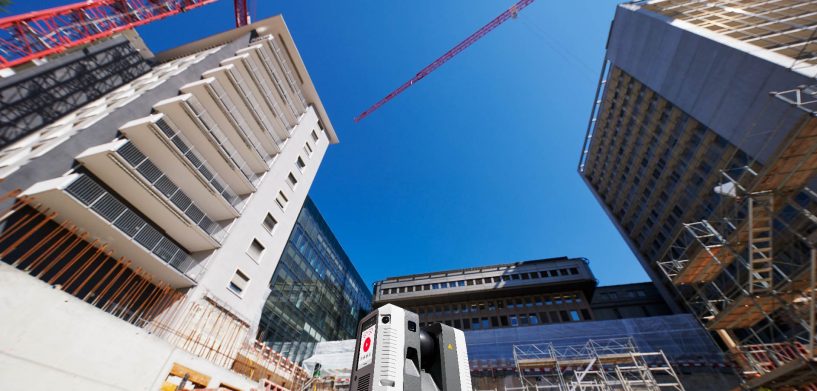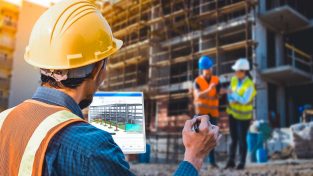Using edge computing to provide highly accurate yet easy-to-read 3D models in the field, the RTC360 registers scans in real time. Combing a high-performance laser scanner with a mobile device app and sophisticated software, scans are captured in less than two minutes.
BK: Welcome to HxGN Radio! My name is Brian. Thank you for joining us today. I have with me Juergen Mayer from Leica Geosystems and Joe Smetanko from WD Partners to discuss the latest laser-scanning solution from Leica Geosystems: the RTC360. Gentlemen, thank you, appreciate you for joining.
JS: You’re welcome.
JM: Thanks for having us.
BK: We’re going to have a unique perspective again here, talking about the laser, but also from a customer perspective too. I’m excited to hear your thoughts on it.
JS: Awesome, I’m excited to give them.
BK: Let me give you a little bit of an overview, and then you get to tell us all the good details, because you’re the expert here. First of all, using edge computing to provide highly accurate yet easy-to-read 3D models in the field, the RTC360 registers scans in real time. Combining a high-performance laser scanner with a mobile device app and sophisticated software, scans are captured in less than two minutes. It’s very cool.
JM: That is very cool. And that is pretty fast as well for a laser scanner.
BK: That’s what I’m coming to understand now, so that’s great. So, tell us a little more in detail about this.
JM: The first thing to mention is that the RTC360 is not only a product, it’s not only a laser scanner, it’s actually part of a whole solution as you — as you’ve read correctly here. It combines the laser scanner itself, but also a field software component and an office software component. And probably the best way to describe it is by the tagline we are using to promote it which is, “fast, agile, precise.” Fast, as we have already alluded to, is really pointing to the fact that it’s so superfast, it will capture 3D data and imaging data in less time than any comparable system on the market. So, it’s blazingly fast. Agile refers more to the second part that you’ve mentioned, this edge computing part. It’s using edge computing to do things in the field directly that traditionally are done in the office, and that adds a lot of benefit to the whole workflow. And precise is — I think that speaks for itself. Needless to say, this being la scanner, it’s delivering really, really crisp, readable data that can be easily interpreted by everyone.
BK: That’s great. So, what applications can this be used in?
JM: Obviously it can be used in a larger variety of applications, but in the design phase of this, we really tried to focus on three distinct applications, the first one being everything to do with as-built documentation in the building construction concept — context. We think that it will provide a lot of benefits to people who want to use it in plant. And the third segment that we really focused on those was public safety for the documentation of like, crash scenes and crime scenes.
BK: Okay. Excellent. So, what kind of benefits does this bring users? I mean you already alluded to those —
JM: Yeah. I mentioned edge computing before. What we mean by this is, there is some very sophisticated technology that allows it to basically see the world around it. It actually always knows where it is. And one of the complications, if you will, of laser scanning is a process called registration, which is stitching the point clouds from different stations together, which again is traditionally an office-processing step. And with this edge computing technology we’re using, we can automate this process completely. So, the user in the field can watch a 3D model literally build up on his tablet screen as he as he collects more data, and can do quality checks directly in the field and adds data – like close-up images, and so on and so forth. And by doing these things directly in the field, the whole process becomes a lot more efficient. And the office processing literally becomes fully automated.
BK: Very nice. Alright, Joe, so from the customer perspective, you’ve had the chance to beta test the RTC360. So, first of all, tell us a little bit about WD Partners and what you do so we can get a feel for how this fits in.
JS: Okay. WD Partners, we’re based out of Columbus, Ohio. We have offices in Mumbai and L.A., in Minneapolis, with a total combined of about almost 400 employees. We are architects and engineers as well as designers. We do probably 90 percent retail industry remodels and takeovers. So, the laser scanning has become a big part of our business recently. Three years ago, honestly. Driven by both client and by internal need. What we do is we work with major retailers (Wal-Mart, Home Depot, Target, Starbucks, CVS) worldwide. And we — we have a hand in pretty much all their remodels, as much as we can.
BK: Yeah.
JS: — get as much business as we can. [All laugh]
BK: Of course.
JM: We all do!
BK: That’s good! That’s good!
JS: Yeah, yeah. And Leica over the last four years, has definitely made that business grow for us. So.
BK: Good. Good. So obviously you enjoy it. But tell us a little about what you and your team both think of the RTC360.
JS: So, the team — we were able to preview it. It came through customs and came to us. First, we saw the PowerPoint — you know, little presentation, and I’ll be honest with you, everybody in the room was skeptical. We were like, you know, what — “How’s it going to do this? How is this going to work?” So, the next day, when it cleared customs and showed up at our door, we set it up, started running, and we were all like, “Wow, it does do that!” Right? So, the first impression was, “wow.”
BK: Yeah. Good.
JS: And the second impression was, “This is going to save us a tremendous amount of time.”
BK: Wow. That’s great!
JS: Now, that was the team. Right. So, then I was able to personally Mike Harvey invited me down to his home. We actually — because he was so busy, we had like a two-day window there. My CEO said, “Go view it, go see what it’s going to do for us.” And we did some real-world testing, out in the field testing. We actually scanned the hotel I was staying at. And it was amazing. My perspective is: amazing. Industry-changing, workflow-changing. Everything about it is just amazing.
BK: So obviously this has been a massive benefit for your company.
JS: Oh, huge. We’re already in our workflows anticipating … as soon as we can get our hands on one, or two, maybe three …
BK: Yeah.
JS: So, we’re anticipating a dramatic increase in efficiency. Dramatic. We’ve already run through all the ROIs on it, all the time savings of spreadsheet after spreadsheet. I put together … my CEO is working directly with me on this. It’s that much of a changer for us, you know, an industry changer.
BK: That’s great. So, what would you tell other industry professionals thinking about using this technology?
JS: First of all, I’d say don’t be afraid.
BK: Sure.
JS: It’s because we were. We were. It took us a while.
BK: Yeah? Why were you afraid? Just change kind of thing? Trying to figure out —
JS: Change thing, yeah. So, we were trying to figure out, is this thing going to do, you know, even with the P16, we started with the P16s, and even with those, we had to get people to trust that it’s going to give you the information you want, and accurately, and then trust that your engineers and your architects will use it in a way that it should be used. That combined with the TrueView software is immense for us. So once that started “infecting,” I say, our company and people start trusting it, they asked for more. More and more and more. Give us more, more, more. This machine gives us more.
BK: Good. Good. Alright, so where do you both see the the future of new edge computing laser scanning going, in the industry in general? And how does the RTC360 fit into that?
JM: As Joe has alluded to, it’s – the fact that it’s so simple to use now, and pretty much everyone can – and now has access to this kind of technology. You know, traditionally, laser scanning used to be the domain of experts … who are experts in laser scanning, not necessarily industry professionals for refurbishments or whatever. And I think it’ll drive the adoption of 3D reality capture in all sorts of industries, and more and more people will adopt it, and we’ll see a big uptake of that kind of technology in all sorts of application fields … maybe some that you don’t even think about now.
JS: Yeah, I agree. As soon as other companies in the same industry as us realise how much simpler this new product and workflow is, they’re going to jump in.
BK: Well, thank you both for sharing this. This is exciting. I’m glad to hear it’s having such an impact in your company as well, and not to mention also on the industry. So, thank you both for being here. Appreciate your time!
JM: Thank you.
JS: Thank you.
BK: For more information on this, please go to leica-geosystems.com as well as wdpartners.com. To listen to additional episodes, hxgnspotlight.com is the place to go. Thank you so much for tuning in. Have a great day!

















